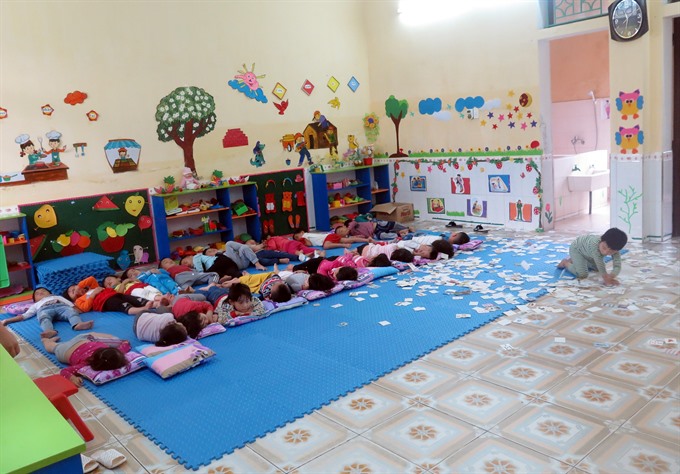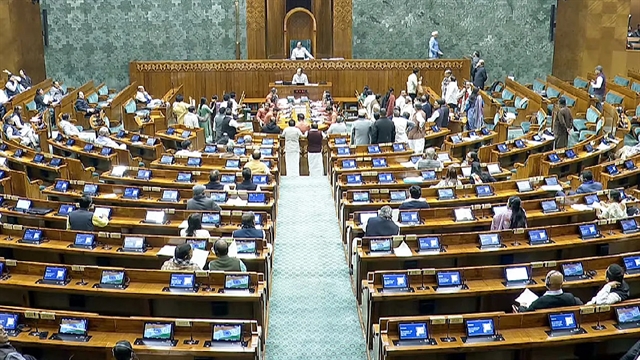.jpg) Society
Society

At the end of November, Nguyễn Tài Ph., a four-year-old boy with autism in Trực Ninh District, Nam Định Province was found tied to a classroom window as his teacher was unable to control him.
 |
| Nguyễn Tài Ph. plays around when his friends having siesta. Ph. is closely monitored by his teachers. - VNA/VNS Photo Vũ Văn Đạt |
HÀ NỘI — At the end of November, Nguyễn Tài Ph., a four-year-old boy with autism in Trực Ninh District, Nam Định Province was found tied to a classroom window as his teacher was unable to control him.
The incident triggered public uproar over the teacher’s actions and also raised the question of Việt Nam’s capacity to offer special needs education for children with autism, disabilities and developmental delays.
According to the Ministry of Labour, Invalids and Social Affairs, by mid-2018, the country had 200,000 autistic people.
The number of children diagnosed with autism has witnessed a rapid increase over the last decade.
Phạm Minh Mục from the Việt Nam National Institute of Educational Sciences told Tuổi trẻ (Youth) newspaper that in 2007 the number of autistic children received by National Pediatric Hospital was 50 times higher than seven years before.
However, as many Vietnamese have little knowledge of the disorder, the true number may be even higher.
Lê Đình Tuấn, director of the Centre for Vocational Guidance and Helping Kids in Integrating Learning, said one of the biggest challenges for children with autism in Việt Nam was that the disorder was not officially recognised as a disability.
Therefore, they cannot enjoy favourable policies, especially in access to education.
“Children with autism lack communication skills. They are excluded, discriminated against and even harassed,” Tuấn said.
As there is no recognition for children with autism, public schools have no responsibility to offer them special education.
Autistic children at public schools face many difficulties, with the lack of skilled and certified teachers in special needs education, especially in small provinces, alarming.
Peng-Sim Eng, a mainstream inclusion mentor who is currently on a seven-month Australian government funded assignment at Kianh Foundation in the central coastal province of Quảng Nam, told Việt Nam News that special needs education in the area was far different from what she had experienced in Australian schools.
“We have a couple of teachers certified in special needs education. However, in terms of technical capacity, they are below what is required to meet the demands of children with diverse disabilities as well as to start an education programme,” she said.
A survey conducted by Nguyễn Hà My, a lecturer of Hà Nội University of Education (HNUE), on syllabuses for integrated classrooms for children with special needs at some primary schools in Hà Nội revealed that more than 70 per cent of the courses did not set special goals for students with developmental delays.
Up to half of the surveyed inclusion teachers did not use special teaching methods for students with disorders.
Only some of them pay attention to students’ conditions and treat them as individuals but mostly based on their experiences, not using trained skills.
In 1999, the Ministry of Education and Training (MoET) established a steering committee on education for children with disabilities. However, only children with physical disabilities have been included. Those suffering from mental and behavioural disorders have been left behind.
Some provincial authorities have asked schools to accept children with disabilities. In fact, a lot of schools are not properly equipped to take care of and teach children with mental and behaviour disorders.
Therefore, autistic children enroll in public mainstream schools but cannot fully integrate.
MoET has been asked by experts to build an assessment tool for students with autism, allow them to not study some subjects and help provide supporting equipment.
Schools receiving children with autism have been asked to train their teachers on special needs education.
According to Mục, every kindergarten or school needs at least one inclusion teacher to support students with special needs.
“We are asking MoET to include the criteria ‘having knowledge and capacity to teach children with disabilities’ in evaluating teachers,” he said.
Family support
Nguyễn Xuân Hải, head of Department of Special Needs Education under HNUE, said a lot of parents could not accept the fact that their children were “abnormal.”
As well as insisting on educational methods used for other children, these parents often refuse to work with teachers to educate their children.
This imposes a barrier on early intervention for children with autism, according to Hải.
Children with intellectual disabilities account for 30 per cent of children with disabilities in Hà Nội, a survey by lecturers Trần Thị Lệ Thu and Nguyễn Thị Linh Chi of HNUE found.
According to the Centre for Autism Research, about 10 per cent of individuals with intellectual disabilities have autism or autistic traits.
However, more than a half of surveyed parents do not have a comprehensive understanding about their children’s conditions.
This prevents children with autism from improving life quality.
“It is not the children who are the major issue, it has to be the children and the family that we need to address. The fact is that we cannot help the children if the parents are not involved,” said Eng.
“Now we’re looking at how to get parents not only be involved but to understand that you need to come with us, to work with us right from the first day your children come to the centre. We can help the children develop. But to ensure that children have better quality of life and future, the family need to be on board,” she added. – VNS

.jpg)


